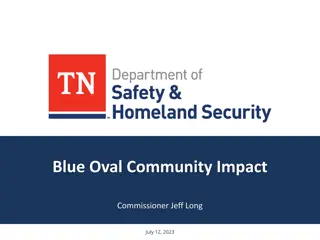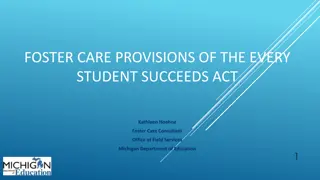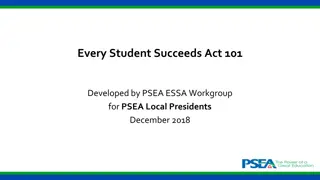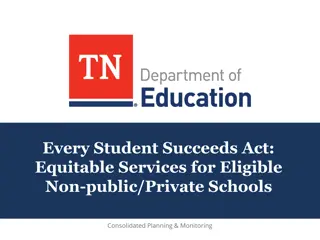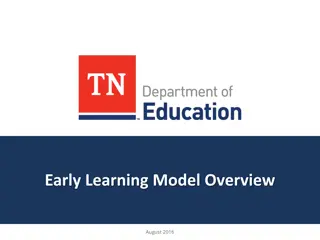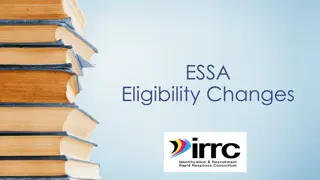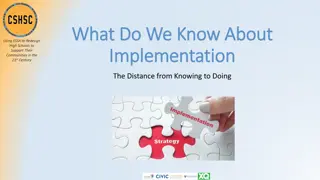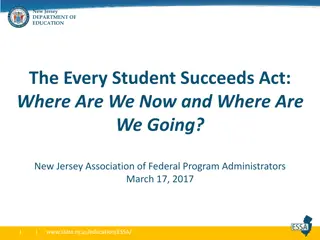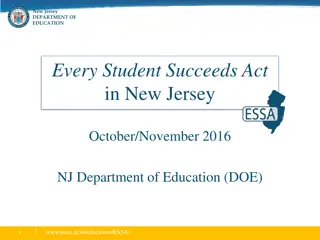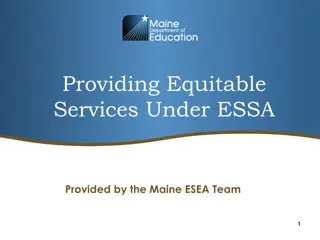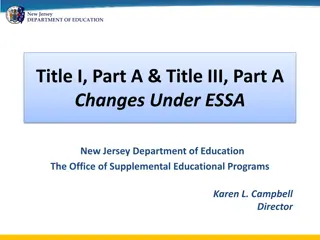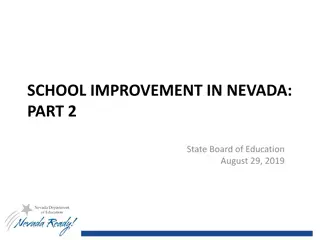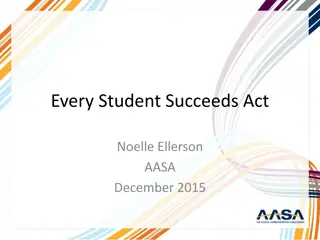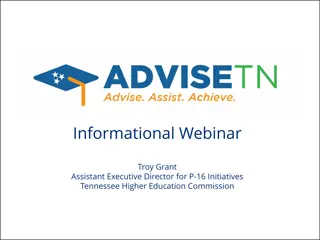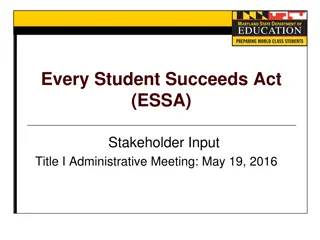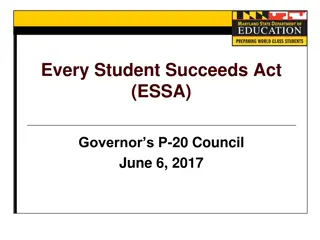Understanding Every Student Succeeds Act (ESSA) in Tennessee - Overview and Key Points
Explore the significance of the Every Student Succeeds Act (ESSA) in Tennessee, including key goals, agenda, timeline, and key differences from previous policies. Learn about ESSA's impact on assessment, accountability, and state decision-making authority, as well as the timeline for implementation and feedback opportunities.
Download Presentation

Please find below an Image/Link to download the presentation.
The content on the website is provided AS IS for your information and personal use only. It may not be sold, licensed, or shared on other websites without obtaining consent from the author. Download presentation by click this link. If you encounter any issues during the download, it is possible that the publisher has removed the file from their server.
E N D
Presentation Transcript
Every Student Succeeds Act in Tennessee Month Day, 2016 Dr. Candice McQueen | Commissioner
Goals 1. Share information about the new Every Student Succeeds (ESSA) Act 2. Share Tennessee s vision, Tennessee Succeeds, as it relates to ESSA opportunities 3. Listen to your ideas, feedback, and opportunities for growth as we draft Tennessee s ESSA plan 4. Share more about how you can continue to give feedback on Tennessee s ESSA plan 2
Agenda ESSA Overview and Timeline (10 minutes) Vision in Tennessee (8 minutes) Specific Plan Components (22 minutes) Standards Assessment Accountability School Improvement Small Group Feedback (45 minutes) Whole Group Debrief (35 minutes)
ESSA Overview and Timeline
Every Student Succeeds Act December 10, 2015 the Every Student Succeeds Act (ESSA) was signed into law. ESSA contains new policies that will affect existing systems and structures for assessment, accountability, and reporting in Tennessee. TDOE is currently engaging with USEd on understanding the law and the implications for our school systems. 6
Key Differences NEW: States now in the driver s seat More authority to make decisions regarding assessments, goals, and accountability standards States also responsible for enforcing many requirements (though subject to USEd regulation) NEW: Consolidates/eliminates smaller grant programs NEW: The big acronyms have been eliminated No more AYP, HQT, or SES NEW: Limitations on Secretarial authority Especially around state plans and waivers 7
Timeline for Implementation ESEA flexibility waivers null and void as of August 1, 2016 States are required to have plans in place and fully implemented by 2017-18, which means the goal is to submit the plan by spring 2017 Report Card with updated elements by fall 2017 9
Timeline for Developing TNs ESSA Plan Stakeholder Feedback Approving the Plan Kick- off Stakeholder Input Writing the Plan May 2016 Dec. 2016 Jan. 2017 Feb. March. 2017 June Sept. 2016 Sept. Nov. 2016 Stakeholders will include directors of schools, principals, educators, parents and students, legislators, governor s office, state board of education, school board members, CORE offices, community organizations, and advocacy groups.
Federal-State-District-School Policy Stakeholder Feedback
OUR VISION Districts and schools in Tennessee will exemplify excellence and equity such that all students are equipped with the knowledge and skills to successfully embark upon their chosen path in life.
OUR GOALS 1 Tennessee will continue rapid improvement and rank in the top half of states on the Report Card. MEASUREMENT Tennessee will rank in top half of states on 4th and 8th grade NAEP in 2019.
GOAL 1 READING
GOAL 1 MATH
OUR GOALS 2 1 The average ACT score in Tennessee will be a 21, allowing more students to earn HOPE scholarships. Tennessee will continue rapid improvement and rank in the top half of states on the Report Card. MEASUREMENT Tennessee will rank in top half of states on 4th and 8th grade NAEP in 2019. MEASUREMENT Tennessee will have an average public ACT composite score of 21 by 2020.
GOAL 2 ACT Composite Scores Over Time Path to Achieving a Statewide Average of 21 on the ACT by 2020 21.5 21 21 20.6 20.5 20.3 20 20 19.7 19.5 19.4 19.3 19.2 19 19 19 18.5 18 2011 2012 2013 2014 2015 2016 2017 2018 2019 2020
OUR GOALS 2 1 3 The average ACT score in Tennessee will be a 21, allowing more students to earn HOPE scholarships. Tennessee will continue rapid improvement and rank in the top half of states on the Report Card. The majority of Tennessee high school graduates will earn a certificate, diploma, or degree. MEASUREMENT Tennessee will rank in top half of states on 4th and 8th grade NAEP in 2019. MEASUREMENT Tennessee will have an average public ACT composite score of 21 by 2020. MEASUREMENT The class of 2020 will be on track to achieve 55% postsecondary completion in six years.
GOAL 3 Postsecondary Enrollment Next Steps After High School Graduation Based on Graduates from Class of 2014 Postsecondary Attainment Next Steps After High School Graduation Based on Graduates from Class of 2008 42% 45% 80% 40% 70% 35% 35% 60% 30% 50% 25% 21% 40% 76% 20% 30% 15% 20% 10% 24% 5% 2% 10% 0% 0% Not 4-year 2-year or less TCAT No postsecondary degree Postsecondary degree enrolled
OUR BELIEFS As we move forward with ESSA implementation in Tennessee, we believe: Tennessee has laid a solid foundation with Improved standards Increased accountability Aligned assessments Tennessee s focus on all students has been critical to our success K-12 must align to postsecondary and workforce needs
Standards ESSA Requirements States must adopt challenging academic standards with a focus on math, English language arts or reading, and science. Tennessee Requirements All standards will be reviewed every six years (per state board). Math, ELA, science and social studies will be reviewed using the rigorous process adopted by the General Assembly in spring 2015 (Public Chapter 423). 25
Assessment Tennessee Requirements TCAP authorized through T.C.A. 49-1- 602 Annual tests in grades 3-8 in math, ELA, science, and social studies Annual tests in high school in math, ELA, science, and social studies EOCs: Algebra I, Algebra II, Geometry, English I, II, and III, U.S. History, Biology I, Chemistry ACT or SAT required in grade 11 by T.C.A. 49-6-6001(b) The Individuals with Disabilities Education Act (IDEA), section 504 of the Rehabilitation Act of 1973, and title I require inclusion of all students with disabilities in the State assessment system. ESSA Requirements Annual state testing for reading and math in grades 3-8 and at least once in high school. Testing of scienceat least three times between grades 3-12. Alternate assessments are to be aligned with alternate academic standards and achievement goals. Only one percent of the total number of all students in the state can be assessed using these alternate assessments.
Assessment: Participation Tennessee Requirements T.C.A. does not include an option to opt out of state-mandated assessments. Except for situations where the Tennessee General Assembly has specifically provided the right to opt out in the law, such as the family life curriculum, parents and/or students may not opt out of state- mandated content or instructional programs, including assessments. ESSA Requirements Continued participation rate of at least 95% of all students and students in each subgroup on all required assessments. LEAs must provide parents with information on state or local policy, procedures, and parental rights regarding student participation in mandated assessments. Nothing in the assessment section of Title I preempts state or local law with respect to a parental decision on assessment participation.
Accountability ESSA Requirements Annual Report Cards required ESSA maintains a requirement for state and district Report Cards to include: Concise description of the accountability system Student achievement on academic assessment for all students and disaggregated by accountability subgroups: Racial and ethnic groups Economically disadvantaged (ED) Students with disabilities (SWD) English learners (EL) Tennessee Requirements Annual Report Card produced for all schools and districts Achievement data reported for the four key subgroups: Black, Hispanic, & Native American (BHN) Economically disadvantaged (ED) Students with disabilities (SWD) English learners (EL) Some accountability results displayed on Report Card regarding AMO targets, but currently, no overall accountability designations 30
Accountability: District-Specific Tennessee Requirements New district accountability system adopted in summer 2015 Three pathways to demonstrate performance for both achievement and gap closure components. Acknowledges student growth between achievement levels and growth using TVAAS (T.C.A. 49-1-603, -605, -606) Incorporates ACT/SAT performance and growth Four district determinations of In Need of Improvement, Progressing, Achieving and Exemplary Districts that fail to meet the 95 percent participation rate in any subject or subgroup designated In Need of Improvement. ESSA Requirements States have the ability to design their own accountability systems and will no longer submit waivers to USEd. In their accountability system, states must consider proficiency on annual assessments a measure of growth on annual assessments graduation rates progress in achieving English language proficiency at least 95 percent of their students participate in all annual assessments measure of school quality and success 31
Accountability: School-Specific ESSA Requirements Annual report cards required Student achievement on academic assessments for all students and disaggregated by all subgroups Number and percentage of English learners achieving English language proficiency Performance on other academic indicators for elementary and secondary schools and high school graduation rates Performance on other indicator(s) of school quality or student success used by the accountability system School quality, climate, and safety, suspensions, expulsions, chronic absenteeism, and more Tennessee Requirements The annual Report Card must include an A-F grading system for schools per new state law TDOE and SBE will work in collaboration to develop A-F grading system criteria Current disaggregation only includes four key subgroups (BHN, ED, EL and SWD) Some non-academic indicators on the Report Card are attendance, suspension rates, and highly-qualified teachers Currently, schools are not included in same accountability framework as districts 32
District Accountability Designation Pathway Achievement Gap Closure Average 2.4 2.1 Determination Achieving Achieving Overall Average Final Determination 2.2 Achieving Progressing Below 2.0 Achieving 2.0 < 3.0 Exemplary 3.0 and above Final District is improving on average but missing growth expectation Determination Key District is meeting growth expectation on average District is exceeding growth expectation on average 33
Minimum Performance Goal Relative rank used for Achievement Goal and BB (or Level 1) reduction. No ranking information displayed to make comparison to prior year ranking. 34
Achievement Determination Heat Map Relative rank used for each content area as one pathway, with TVAAS as a second pathway. 35
Gap Closure Determination Heat Map Black/Hispanic/ Native American 2 2 4 3 2 3 3 2 Economically Disadvantaged 1 2 3 2 3 1 2 0 Students with Disabilities 2 1 0 3 4 1 2 2 Content Area English Learners 3-5 Math 3-5 ELA 6-8 Math 6-8 ELA High School Math High School ELA ACT Composite Graduation Rate Subgroup Average District Gap Closure Determination 2.6 1.8 1.9 2.1 Achieving 36
District Accountability Designation Pathway Achievement Gap Closure Average 2.4 2.1 Determination Achieving Achieving Overall Average Final Determination 2.2 Achieving Progressing Below 2.0 Achieving 2.0 < 3.0 Exemplary 3.0 and above Final District is improving on average but missing growth expectation Determination Key District is meeting growth expectation on average District is exceeding growth expectation on average 37
School Improvement
School Improvement ESSA Requirements Identify Comprehensive Support Schools once every three years Lowest performing 5 percent of Title I schools High schools with graduation rates below 67 percent Schools with achievement gaps Districts must design and implement evidence-based turnaround plans in conjunction with community input. If school has not improved over the course of no more than four years, the state must intervene. Tennessee Requirements Create Priority School List (bottom 5 percent) based on academic achievement and Focus School List (bottom 10 percent) based on achievement gaps every three years (T.C.A. 49-1-602) TN system incorporates ESSA required factors with the exception of a measure of school quality and student success Support of district-led iZones ASD intervention for lowest- performing schools (T.C.A. 49-1- 602) 39
Small Group Feedback
Discussion Questions Assessments 1. How should we continue strengthening ways to measure student progress toward meeting state academic standards? 2. How could we strengthen the current state assessment system? Accountability 3. Given that Tennessee s district accountability system is new, how might we strengthen it? 4. What other system quality measure might you include in the district accountability framework? 5. What measures of school quality or student success should be included in the school accountability framework?
Whole Group Debrief
Districts and schools in Tennessee will exemplify excellence and equity such that all students are equipped with the knowledge and skills to successfully embark on their chosen path in life. Excellence | Optimism | Judgment | Courage | Teamwork



